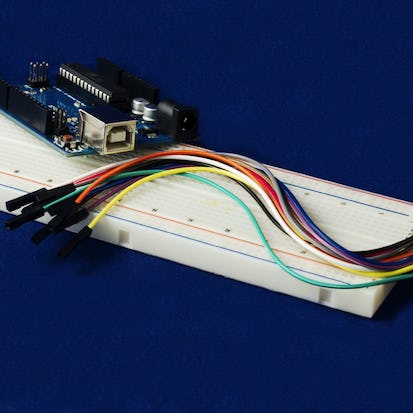- Level Foundation
- المدة 13 ساعات hours
- الطبع بواسطة University of California, Irvine
-
Offered by

عن
The Arduino is an open-source computer hardware/software platform for building digital devices and interactive objects that can sense and control the physical world around them. In this class you will learn how the Arduino platform works in terms of the physical board and libraries and the IDE (integrated development environment). You will also learn about shields, which are smaller boards that plug into the main Arduino board to perform other functions such as sensing light, heat, GPS tracking, or providing a user interface display. The course will also cover programming the Arduino using C code and accessing the pins on the board via the software to control external devices. Please note that this course does not include discussion forums. Upon completing this course, you will be able to: 1. Outline the composition of the Arduino development board 2. Describe what it means to program the board's firmware 3. Read board schematics 4. Install Arduino IDE 5. Describe what "shields" are and how they are used 6. Specify the role of libraries in the use of shields 7. Compile and run a program 8. Name C Variables and Types 9. Name common C operators 10. Use conditionals and loops 11. Explain functions, their definition and invocation 12. Explain the implications of global variables 13. Undertake the Arduino build process 14. Describe the role of the tools behind the IDE 15. Describe how to invoke functions in classes 16. Explain the structure of an Arduino sketch 17. Access the pins of the Arduino 18. Differentiate between digital and analog pin 19. Debug embedded software 20. Explain the importance of controllability and observability in the debugging process 21. Describe common debugging architectures for embedded systems 22. Explain how the UART Serial communication protocol works 23. Describe how the Arduino Serial library performs serial communicationالوحدات
----Get Started----
2
Readings
- Pre-Course Survey
- Course Overview
----Module 1----
1
Videos
- Module 1 Introduction (video)
2
Readings
- Module 1 Objectives
- Module 1 Reading
----Lesson 1----
3
Videos
- Lecture 1.1: Arduino Platform
- Lecture 1.2: Arduino Board
- Lecture 1.3: Direct Programming
----Lesson 2----
3
Videos
- Lecture 2.1: Arduino Schematics
- Lecture 2.2: Arduino IDE
- Lecture 2.3: Compiling Code
----Lesson 3----
2
Videos
- Lecture 3.1: Arduino Shields and Libraries
- Lecture 3.2: Arduino Basic Setup
----Quiz & Peer Review----
1
Assignment
- Module 1 Quiz
1
Peer Review
- Install the Arduino IDE on your computer
----Module 2----
1
Videos
- Module 2 Introduction (video)
4
Readings
- Module 2 Objectives
- Module 2 Mandatory Reading
- Module 2, Recommended Reading
- Planning Ahead for Modules 3 and 4
----Lesson 1----
3
Videos
- Lecture 1.1: Setting Up Your Environment
- Lecture 1.2: Hello World
- Lecture 1.3: Variables
----Lesson 2----
3
Videos
- Lecture 2.1: Basic C Operators
- Lecture 2.2: Conditionals
- Lecture 2.3: Loops
----Lesson 3----
2
Videos
- Lecture 3.1: Functions
- Lecture 3.2: Global Variables
----Quiz and Peer Review----
1
Assignment
- Module 2 Quiz
1
Peer Review
- Program to compute Fibonacci sequence
----Module 3----
1
Videos
- Module 3 Introduction (video)
3
Readings
- Module 3 Objectives
- Module 3 Reading
- Information About the Arduino
----Lesson 1----
3
Videos
- Lecture 1.1: Arduino Toolchain
- Lecture 1.2: Cross-Compilation
- Lecture 1.3: Arduino Sketches
-----Lesson 2----
3
Videos
- Lecture 2.1: Classes
- Lecture 2.2: Sketch Structure
- Lecture 2.3: Pins
----Lesson 3----
3
Videos
- Lecture 3.1: Input and Output
- Lecture 3.2: Blink Example
- Video Demonstration: Arduino Blink Example
----Quiz and Peer Review----
1
Assignment
- Module 3 Quiz
1
Peer Review
- Module 3 Peer Review
----Module 4----
1
Videos
- Module 4 Introduction (video)
3
Readings
- Module 4 Objectives
- Module 4 Reading
- Information about the Arduino
----Lesson 1----
3
Videos
- Lecture 1.1: Debugging
- Lecture 1.2: Debug Environments
- Lecture 1.3: Debug via Serial
----Lesson 2----
3
Videos
- Lecture 2.1: UART Protocol
- Lecture 2.2: UART Synchronization
- Lecture 2.3: UART Parity and Stop
----Lesson 3----
2
Videos
- Lecture 3.1: Serial on Arduino (Updated)
- Lecture 3.2: Reading from Serial
----Quiz and Peer Review----
1
Assignment
- Module 4 Quiz
1
Peer Review
- Module 4 Peer Review
----Please Complete this Survey----
1
Readings
- End-of-Course Survey
Auto Summary
Explore the world of digital devices with "The Arduino Platform and C Programming" course, ideal for beginners in IT & Computer Science. Led by Coursera, this foundational course dives into the workings of the Arduino hardware and software, including its IDE, shields, and C programming. Over 780 minutes, you'll master skills from installing the Arduino IDE to debugging embedded software. Perfect for tech enthusiasts aiming to control physical devices through coding, with flexible subscription options available.

Ian Harris


